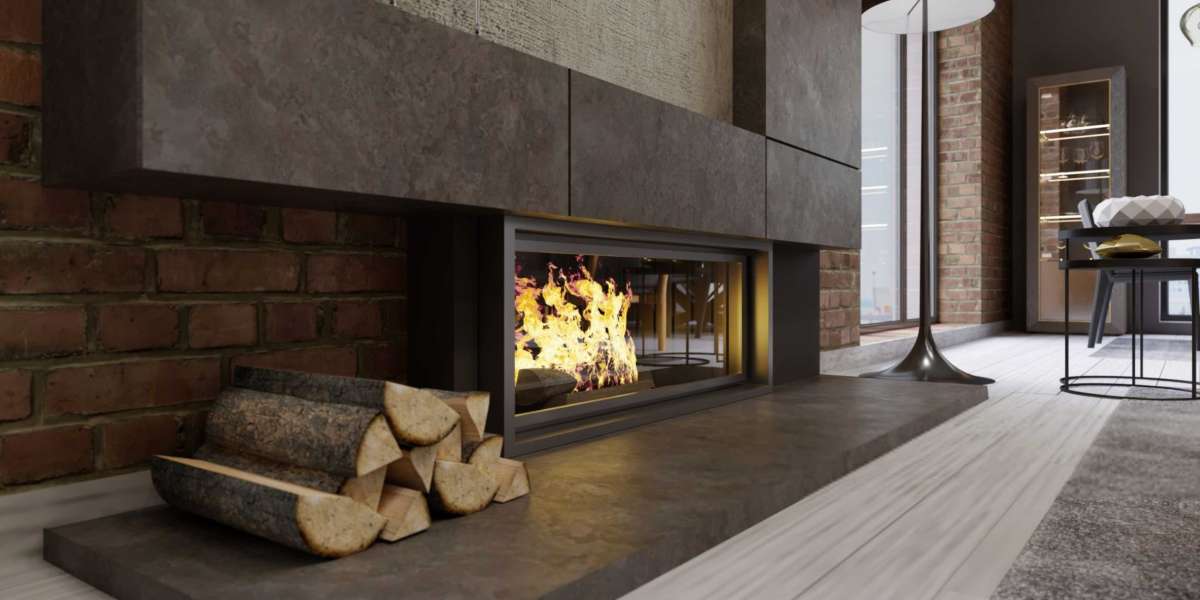Bioethanol fireplaces are a unique type of heater that feature a real, vibrant flame but don't require a chimney, ventilation, or a foundation. These devices are simple, and with a quick read of the manufacturer’s instructions and adherence to basic safety rules, you can easily manage them yourself. However, the challenge lies in deciding which bioethanol fireplace to buy. With such a variety of models, styles, shapes, sizes, and installation methods, bioethanol fireplaces offer more options than other types of heaters. Additionally, when choosing, it's essential to consider power and heat output to ensure that your fireplace will be comfortable in both a small city apartment and a spacious country home.
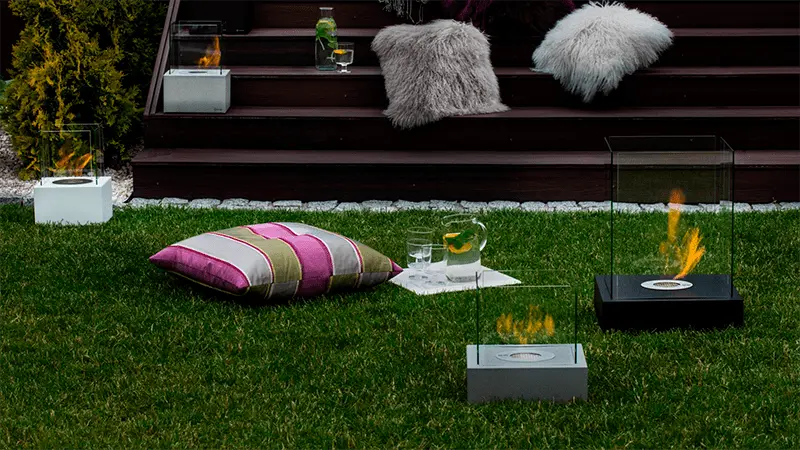
Advantages of Bioethanol Fireplaces Compared to Traditional Ones
The primary advantage of a bioethanol fireplace is that it doesn’t require a chimney, special ventilation, or a permanent installation spot. The unit is portable, lightweight, and can easily be moved and set up in a new location within a room. There’s no need to stockpile fuel or designate a special storage area—just store the bioethanol in a safe, child-proof place. Setting up is simple: take the fireplace out of the packaging, place it in a fire-safe area, fill the fuel tank with bioethanol, open the burner, and light the flame with a long lighter.
Eco-Friendliness and Safety of Bioethanol Fireplaces
A bioethanol fireplace is environmentally friendly and burns very little oxygen—about the same amount as three candles. The fire burns brightly without producing soot, ash, smoke, unpleasant odors, or harmful emissions, keeping the glass panels clean.
The fireplace body doesn’t overheat, making small models safe to place on tables, nightstands, or bookshelves. There are even models designed to hang on walls like artwork, with a built-in air-cooling system. Floor and tabletop versions often feature an automatic shut-off mechanism that turns off the device if it's accidentally knocked over, extinguishing the flame and preventing fuel spills.
What Fuel is Used in These Fireplaces?
Bioethanol fireplaces use denatured bioethanol as fuel. Bioethanol is produced from plant-based materials such as beets, corn, sugarcane, wheat, straw, and wood. This results in a combustible liquid that is completely harmless to humans and the environment, producing a vibrant, live flame.
Bioethanol is sold in plastic bottles or canisters of various sizes. Some manufacturers add scents or aromas that mimic pine, sea salt, or flowers and can even replicate the crackling sound of fire. However, strong scents are not for everyone and should be chosen carefully.
Store the fuel in its original packaging in a child-proof location. While bioethanol is non-toxic when burned, accidental ingestion can lead to serious poisoning.
Ease of Use and Efficiency
Bioethanol fireplaces are simple in design: a fuel container, a burner, and a stainless steel body with heat-resistant glass panels. While models vary in appearance, they all operate on the same principle. Fill the fuel tank with ethanol, ignite the burner with a long lighter, and enjoy the bright flame. The flame height and intensity can be adjusted with a shutter.
Bioethanol fireplaces are considered decorative devices and design elements. They aren't intended for full-scale heating, but 1 liter of bioethanol produces approximately 5.7 kWh of heat energy. A large, reliable bioethanol fireplace can raise the temperature in a room by 3–4°C due to the heat generated by the metal body.
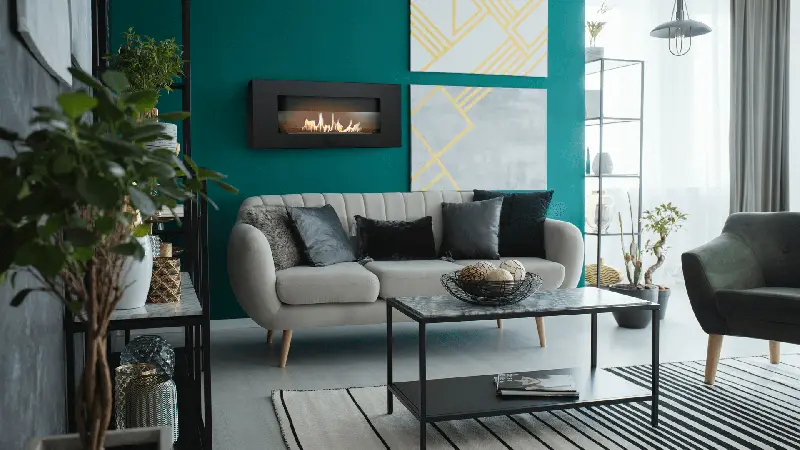
Variety of Designs
There are countless design options: mini fireplaces that sit on tables or shelves, classic models with a mantel, wall-mounted, panoramic, and floor-standing fireplaces. For outdoor terraces or garden spaces, open fireplaces without glass are available.
The flame placement varies by model. In floor-standing versions, the flame burns vertically, while in larger wall-mounted or built-in models, the burner runs horizontally along the entire body. Designers often play with combinations of stainless steel and heat-resistant glass of different shapes. The steel body may be shaped like a cube, sphere, pyramid, hemisphere, or polygon.
Types of Bioethanol Fireplaces by Installation Type
Bioethanol fireplaces are easy to maintain, allowing designers to focus on a wide variety of styles. Fireplaces vary in style, size, and installation methods. Choose an ethanol fireplace based on the room's size while following basic fire safety rules. In smaller living rooms, libraries, bedrooms, or offices, tabletop and wall-mounted options are ideal. For larger dining rooms or studio apartments, island-style fireplaces offer a 360-degree view of the fire.
Wall-Mounted Fireplaces
Wall-mounted fireplaces resemble paintings or flat-screen TVs and are ideal for smaller rooms (starting from 10 m²) as they don't take up much space. However, it’s important to ensure proper ventilation in small rooms. These fireplaces are mounted with screws, and the rear wall is equipped with a special screen to prevent heat from damaging the wall.
The flame burns behind a transparent panel, stretching horizontally across the length of the fireplace. The body may take various shapes, such as a box, pyramid, oval, triangular shelf with glass, or a flat, thin panel, often framed in stainless steel in metallic, black, or gray tones.
Tabletop Bioethanol Fireplaces
A tabletop bioethanol fireplace is a small unit with a bright flame. It can be placed on tables, bookshelves, or coffee tables. Small bioethanol fireplaces consist of a steel fuel tank, a ceramic conductor, and a burner. The body may be shaped like a cube, sphere, or boat. Some versions include heat-resistant glass panels or intricate metalwork, while others leave the flame open. These lightweight mini fireplaces are easy to move and set up in living rooms, bedrooms, libraries, or terraces, creating a special atmosphere in restaurants or cafes. They are also safe, producing no sparks, soot, or smoke.
Corner Bioethanol Fireplaces
Compact corner fireplaces are perfect for small spaces. They can be installed on the floor, mounted on the wall, or used to frame a corner with a panel-like design. Some open models leave the flame unprotected by glass, while closed models enclose the flame behind a transparent panel.
Corner fireplaces come in various shapes, such as an elongated stand, triangular shelf, or box. Some feature a high flame encased in a curved corner. For classic interiors, choose a corner bioethanol fireplace with a mantel and decorative shelf, often made from wood, stone, marble, or MDF.
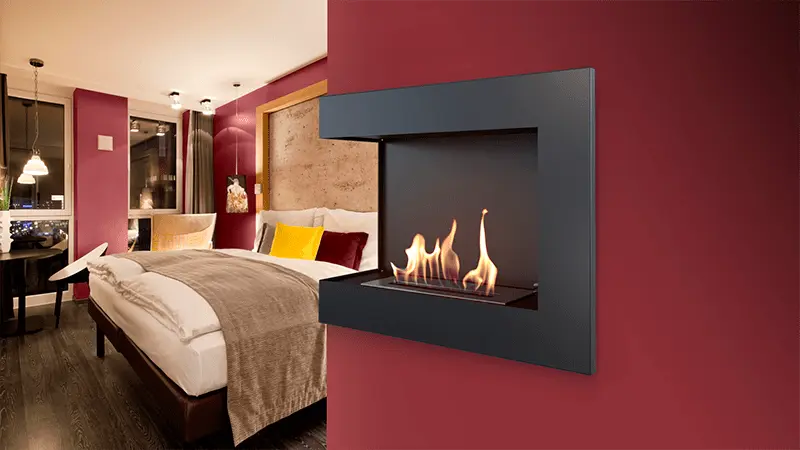
Built-in Bioethanol Fireplaces
Built-in bioethanol fireplaces resemble traditional heaters and are installed in the center of a wall, framed by decorative panels. These fireplaces are available in both classic and modern minimalist styles. The flame is tall and bright, often surrounded by ceramic "logs" or stones for decoration. This type of fireplace is ideal for creating a cozy seating area with chairs and a coffee table.
One option is a panoramic closed bioethanol fireplace, perfect for loft, modern, or minimalist interiors. It’s installed in a wall in such a way that the horizontal flame is visible from two different rooms.
Freestanding Bioethanol Fireplaces
Freestanding or island fireplaces are placed in the center of large halls, studio apartments, or terraces. They help divide the space, and the live flame can be seen from all angles. Freestanding fireplaces are easy to move, allowing for new design layouts or cozy seating areas. The body can be installed on a decorative stand or placed directly on the floor without any special foundation or protection. The flame can burn openly or be enclosed by glass panels, and the body can take various shapes, such as a sphere, cube, polygon, or bowl. Some designs feature the flame behind intricate metal panels.
Types of Bioethanol Fireplaces by Control Method
Bioethanol fireplaces can be categorized by their control method: manual, semi-automatic, or fully automatic. The price increases with automation, making fully automatic models the most expensive.
Manual Bioethanol Fireplaces
Wall-mounted, tabletop, built-in, and some floor-standing and outdoor bioethanol fireplaces are controlled manually. These autonomous units don't require electricity, making them easy to move and set up both indoors and outdoors. In manual fireplaces, the flame’s height and intensity are adjusted with burner sliders. The fuel tank usually holds up to three liters, providing 5–7 hours of burn time. Since manual fireplaces don’t have control panels or safety sensors, fuel usage is calculated manually. These fireplaces are typically more affordable than automatic models.
Key Criteria for Choosing a Bioethanol Fireplace
Buying a bioethanol fireplace is a significant investment. The device will last for at least ten years, so it's essential to decide whether you want a large, stationary model or a small, portable one. Mini fireplaces can easily be moved, while built-in, floor-standing, and corner models are more permanent fixtures that will be part of the room’s design for at least a decade. While interiors can be changed, the fireplace remains the same, so it’s important to choose the right size, style, color, and finish, and decide on the installation method. Also, consider the cost of bioethanol fuel and accessories.
Fireplace Design and Style
Bioethanol fireplaces come in a wide variety of designs, making it easy to find the perfect match for any interior, whether it’s a modern high-tech apartment or a classic home. Some models focus on the flame itself, with minimal decoration, just a simple steel frame in the shape of a cube or pyramid. Other models emphasize unique design features, such as steel spheres, polygons, or abstract forms combined with glass or intricate metalwork. Styles range from classic to modern, minimalist, high-tech, or Provence.
Fireplace Materials and Their Impact on Design
Bioethanol fireplace bodies are made from heat-resistant stainless steel. The surface can be polished or coated with powder paint. Powder coating technology provides a durable, glossy, matte, or textured finish that can withstand temperature changes. Colors range from white and metallic gold to black. Stainless steel is flexible and easy to shape, allowing for a wide variety of designs.
Modern and Classic Design Solutions for Your Interior
The hallmark of a classic fireplace is the mantel, often decorated with moldings, reliefs, or columns, and made from marble, stone, or brick. It’s usually installed against a wall in the center or corner of the room. Modern bioethanol fireplace designs include island, wall-mounted, tabletop, portal-style, and corner models, with the flame positioned horizontally or vertically. Shapes range from flat rectangular screens to spheres with bright flames inside.
What Size Fireplace is Right for Your Space?
Bioethanol fireplaces are not designed for full-scale heating, which can be considered one of their few drawbacks. These devices are not intended for continuous use, unlike electric or wood-burning stoves. However, they can raise the room temperature by a few degrees. A fireplace that's too large for a small living room or bedroom will burn oxygen too quickly, reducing comfort. The recommended power output is 1 kW per 10 m². For tabletop models, the output is around 0.5 kW. A fireplace with 1 kW of power can heat a 10 m² room. The most common power output is 2.5 kW, which comfortably heats a dining room or library of 25 m².
What Heat Output to Expect
Bioethanol fireplaces produce real flames with a temperature of up to 900°C. All the heat generated is released directly into the room. The metal fuel tank, steel components, and glass panels also heat up. The fireplace heats up quickly, usually within 15–30 minutes of being turned on. The amount of heat produced depends on the length of the flame line, which can range from 50 cm to several meters in different models. One liter of bioethanol generates about 5.7 kWh. To calculate the required power for a room, divide the room's volume by 30.
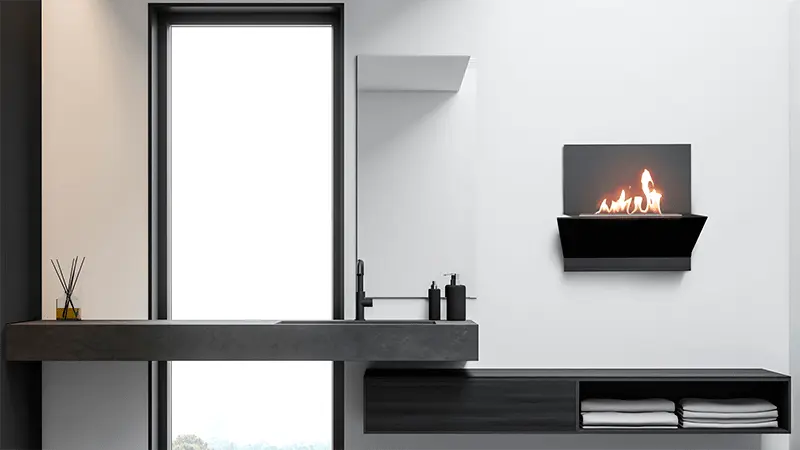
Installation Methods for Bioethanol Fireplaces
Tabletop and outdoor fireplaces are easy to install—simply place them on a stable, flat surface. It’s important to keep the area around the open flame free of clutter.
When installing larger fireplaces, first choose a location with a constant supply of fresh air, ensuring at least one meter of space between the fireplace and any flammable materials. If the model requires electricity, provide access to wiring.
Wall-mounted fireplaces are hung like a picture or television using brackets. They come with a rear protective panel that prevents the unit from overheating and keeps the wall cool. Bioethanol fireplaces can even be mounted on wallpapered walls. It’s recommended to avoid placing the unit where direct sunlight will shine on it, as this will affect the view of the flame.
Built-in models are installed in wall niches between rooms or in furniture with false panels made of drywall. These fireplaces are made with reinforced frames that can withstand construction loads. Since the body heats up, a protective box made from heat-resistant materials is installed between the wall and the fireplace.
Corner fireplaces are installed in various ways. Some are freestanding, while others are mounted in a corner, resembling traditional fireplaces. Another option is to frame a protruding corner with a panel design. Some models are mounted on the end wall of a room, dividing the space into zones with a flame visible from both sides.
Freestanding fireplaces require ample space, with no surrounding furniture. They don't need any special preparation, but it’s important to ensure the fireplace is stable and positioned so the flame is visible from multiple angles.
Costs for Bioethanol Fuel and Maintenance
Bioethanol fireplaces aren’t typically used as a main heating source. Instead, they are lit to create a cozy atmosphere for an evening or special event. It’s important to calculate how much fuel you’ll need per hour and ensure you have enough on hand. Prices vary depending on the manufacturer and the size of the container—typically 1 or 5 liters.
Owners can maintain bioethanol fireplaces themselves, as they require minimal care. A professional may be needed if the device starts working inconsistently.
User Reviews and Expert Ratings
Bioethanol fireplaces are highly regarded by users as an excellent addition to city apartments. There are many varieties of devices with real, safe flames that can be used even in small bedrooms or living rooms. Additionally, tabletop and freestanding fireplaces are easy to move and reposition. A traditional large fireplace is not suitable for apartments due to the need for a chimney and ventilation, but a bioethanol fireplace can be installed and maintained by the owner.
The main challenge for buyers is choosing among the many available models in terms of style, power, and function. Even a small fireplace with a live flame can create a cozy atmosphere in a living room, office, or library. The key is to select the right power and design.
Experts rank bioethanol fireplaces based on the following characteristics: manufacturer, model range, class, control method, design features, style, and price segment. Manufacturing devices that are expected to last at least ten years is a labor-intensive process that involves continuous technological improvement. Therefore, it’s important to trust brands that have established a reputation in Ukraine and other European markets.
Cleaning and Maintenance Tips for Bioethanol Fireplaces
Among the many advantages of bioethanol fireplaces is their simple design and maintenance. Floor-standing, wall-mounted, and mini fireplaces are easy to unpack, set up on a flat surface, fill with fuel, and light. Built-in fireplaces take a bit more time to install but require little maintenance once set up. Be sure to read the manufacturer’s instructions carefully before use. Pay special attention to the functions of automatic and semi-automatic models to make the most of their features.
Why Customers Choose Bioethanol Fireplaces
Bioethanol fireplaces are an excellent choice for those who want to add the charm of a live flame to their home without making significant structural changes or redesigns. Ethanol produces no harmful emissions or odors and is environmentally friendly, consuming much less oxygen compared to wood-burning or gas fireplaces. Beautiful bioethanol fireplaces can decorate living rooms, bedrooms, libraries, and offices, both in private homes and city apartments, without the need for a chimney. The options are endless, from mini fireplaces for a bookshelf to long burners several meters wide. Styles range from classic with a mantel to modern, minimalist, high-tech, or loft.
Maintaining a bioethanol fireplace is as simple as occasionally wiping the body and glass. These fireplaces are safe for homes with pets and small children, as they automatically shut off if accidentally tipped over.
